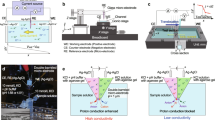Abstract
-
1.
Tip potential (TP) of glass microelectrodes filled with 3 M KCl increased remarkably with the increase in the storage period in 3 M KCl solution at 37‡ C, while the electrode resistances decreased gradually.
-
2.
The electrical conductivity through the thin glass wall near the tip was found to increase in parallel with the TP increase.
-
3.
The e.m.f. across the thin glass wall in the tip region was directly measured. This seems to contribute to the TP generation of the microelectrode when the conductivity of the glass wall is significantly high in the tip region.
-
4.
Effects of the acid treatment of glass employed and the acidification of fillant electrolyte solution suggested that fixed negative charges on the glass wall play a fundamental role in the TP formation.
-
5.
Based on these experimental results, it was concluded that not only the diffusion potential through the tip pore but also the interfacial potential through the thin glass wall near the tip contributes to the TP generation, and the contribution of the latter increases with a long exposure period of the electrodes to electrolyte solution.
-
6.
In this connection, technical problems related to reduction of the tip potential were also discussed.
Similar content being viewed by others
References
Adrian, R. H.: The effect of internal and external potassium concentration on the membrane potential of frog muscle. J. Physiol. (Lond.) 133, 631–658 (1956)
Agin, D.: Electrochemical properties of glass microelectrodes. In: Glass microelectrodes (eds. M. Lavallée, O. F. Schanne, N. C. Hébert). New York: John Wiley 1969
Agin, D., Holtzman, D.: Glass microelectrodes: the origin and elimination of tip potentials. Nature (Lond.) 211, 1194–1195 (1966)
Bils, R. F., Lavallée, M.: Measurement of glass microelectrodes. Experientia (Basel) 20, 231–232 (1964)
Bingley, M. S.: Saline-filled micro-electrodes in relation to membrane potential measurement in fresh water protozoa. Nature (Lond.) 202, 1218–1219 (1964)
Caillé, J. P., Gagné, S.: Résistance électrique de la paroi d'une microélectrode. Canad. J. Physiol. Pharmacol. 49, 783–786 (1971)
Chapman, D. L.: A contribution to the theory of electrocapillarity. Phil. Mag. 25, 475–481 (1913)
Frank, F., Becker, M. C.: Microelectrodes for recording and stimulation. In: Physical techniques in biological research, vol. V, (ed. W. L. Nastuk). New York-London: Academic Press 1964
Gouy, G.: Sur le constitution de la charge électrique à la surface d'un electrolyte. J. Physique 9, 457–468 (1910)
Hülser, D. F., Webb, D. J.: The use of the tip potential of glass microelectrodes in the determination of low cell membrane potentials. Biophysik 10, 273–280 (1973)
Kawabata, G., Nakamura, Y.: On the Henderson's equation concerning the tip-potential of microelectrode. Bull. Yamaguchi med. Sch. 12, 1–4 (1965)
Lavallée, M.: Intracellular pH of rat atrial muscle fibers measured by glass micropipette electrodes. Circulat. Res. 15, 185–193 (1964)
Lavallée, M., Szabo, G.: The effect of glass surface conductivity phenomena on the tip potential of glass micropipette electrode. In: Glass microelectrodes (eds. M. Lavallée, O. F. Schanne, N. C. Hébert). New York: John Wiley 1969
Ling, G., Gerard, R. W.: The normal membrane potential of frog sartorius fibers. J. cell. comp. Physiol. 34, 383–396 (1949)
Nastuk, W. L., Hodgkin, A. L.: The electrical activity of single muscle fibers. J. cell. comp. Physiol. 35, 39–73 (1950)
Okada, Y., Inouye, A.: Tip potential and fixed charges on the glass wall of microelectrode. Experientia (Basel) 31, 545–546 (1975)
Okada, Y., Ogawa, M., Aoki, N., Izutsu, K.: The effect of K+ on the membrane potential in HeLa cells. Bioohim. biophys. Acta (Amst.) 291, 116–126 (1973)
Riemer, J., Mayer, C., Ulbrecht, G.: Determination of membrane potential in smooth muscle cells using microelectrodes with reduced tip potential. Pflügers Arch. 349, 267–275 (1974)
Snell, F. M.: Some electrical properties of fine-tipped pipette microelectrodes. In: Glass microelectrodes (eds. M. Lavallée, O. F. Schanne, N. C. Hébert). New York: John Wiley 1969
Tasaki, I., Polley, E. H., Orrego, F.: Action potentials from individual elements in cat geniculate and striate cortex. J. Neurophysiol. 17, 454–474 (1954)
Tasaki, K., Tsukahara, Y., Ito, S., Wayner, M. J., Yu, W. Y.: A simple, direct and rapid method for filling microelectrodes. Physiol. Behav. 3, 1009–1010 (1968)
Wann, K. T., Goldsmith, M. W.: Reduction of tip potential artefacts in microelectrode measurements. Nature (Lond.) 238, 44–45 (1972)
Williams, J. A., Withrow, C. D., Woodbury, D. M.: Effects of ouabain and diphenylhydantoin on transmembrane potentials, intracellular electrolytes, and cell pH of rat muscle and liver in vivo. J. Physiol. (Lond.) 212, 101–115 (1971)
Author information
Authors and Affiliations
Rights and permissions
About this article
Cite this article
Okada, Y., Inouye, A. Studies on the origin of the tip potential of glass microelectrode. Biophys. Struct. Mechanism 2, 31–42 (1976). https://doi.org/10.1007/BF00535651
Received:
Accepted:
Issue Date:
DOI: https://doi.org/10.1007/BF00535651




